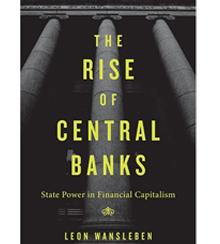Quantitative easing made easy
A new book questions the growing power and influence of central banks.

The Rise of Central Banks: State Power in Financial Capitalism
by Leon Wansleben, Harvard University Press, 2023
In 2007, an economist at Carnegie Mellon University wrote a paper in praise of central banks. “How the world achieved consensus on monetary policy” described the way in which the US Federal Reserve and its counterparts in Canada, New Zealand, the UK, and other European countries had hit upon a set of policies that had brought down the rampant inflation of the 1970s and early 1980s, promoted full employment, and nurtured economic growth. This was the so-called Great Moderation. But by the time the economist, Marvin Goodfriend, published his paper, Bear Stearns had liquidated two hedge funds that had exposure to US subprime mortgages, and a highly leveraged British bank, Northern Rock, was being bailed out by the Bank of England. The global financial crisis had already arrived.
Clearly, Goodfriend’s paper did not age well. It is offered up within The Rise of Central Banks, a new book by Leon Wansleben, an academic at the Max Planck Institute, as evidence of the complacency that had taken hold among monetary policymakers after years of favorable economic conditions. However, Wansleben’s argument goes further: central bankers were not merely lulled into a false sense of security by years of benign conditions. Instead, over the past half century, they sought more power and influence from their governments, pursued deregulation, and then showed a lack of interest in monitoring the complex financial markets that they had spurred on to rapid growth. The final act in this drama, Wansleben argues, is their growing reliance on quantitative easing, a tool that he believes serves central banks but also drives inequality.
This spiky, engaging stance runs counter to much of the post–global financial crisis literature. The conventional wisdom holds that central banks not only rescued the global economy twice over, once in 2008–09 and again in early 2020, providing funding on a scale that intimidated politicians everywhere, but that in the years since the financial crisis, they have worked to reduce the risk of additional, similar catastrophes. These measures include stress tests for banks (which must now hold greater proportions of capital and are more restricted in their volume of higher-leveraged lending), stiffer rules on the management of hedge funds, and more direct engagement with sources of systemic risk, from terrorism to climate change. The Bank of New Zealand, for example, amended its mandate so that it must consider the impact of monetary policy on the housing market.
That central banks have risen in prominence is inarguable. Wansleben identifies two crucial moments in their ascent. The first was the appointment of Paul Volcker as US Fed chair, in 1979, amid soaring inflation and, particularly, rising inflationary expectations. At the time, the Fed, like other central banks, sought to control the rate of inflation by making changes to the money supply. But the relationship between monetary inflation and supply was in the process of breaking down, partly because of ongoing deregulation in the financial sector that made the volume of money in the economy harder to track and control. Volcker’s early attempts to use monetary targeting failed, so he tried a new strategy. He repeatedly raised the policy interest rate, even when the economy was shrinking and inflation was slowing, until it became clear that long-term inflationary expectations were coming down. For Wansleben, this moment is important because it shows the start of a major shift in how monetary policy is conducted, and because it showed that Volcker “cared most about financial market expectations,” a theme that runs through The Rise of Central Banks.
Three decades later, the second essential moment in Wansleben’s framing arrives in the form of the global financial crisis. He argues that the crisis “was not an accident of history, but a symptom of deeper dislocations in Western capitalism,” and he lays much of the blame for its existence at the door of central banks. Curiously, Wansleben deemphasizes other critical factors, such as the role of credit-ratings agencies and weak regulation of the mortgage-backed securities market, which destabilized the system and led to contagion. Instead, he focuses on central bankers and their influence on inflation; and that inflation was not held down by their mastery of financial markets but by other developments, such as the weakness of the labor movement and the influx of cheap imports from China. Central banks claimed “exclusive ownership over price stability while shedding responsibility for regulation,” partly to avoid conflict with the banking sector. And by pursuing deflationary policies, Wansleben contends, they helped make low-income workers worse off and pushed them to accumulate unsustainable levels of debt to maintain their standard of living.
Wansleben argues further, that in spite of any culpability, central banks emerged from the crisis with their position at the heart of the global economy strengthened. Governments, on their own, lacked the conviction and firepower to rescue the global economy. Instead, central banks stepped in and delivered the coordinated action that prevented the total seizure of the global economy in late 2008, a fact that Wansleben does not dwell on. It is true that their main tool in keeping the lights on—quantitative easing—disproportionately benefits the rich and has helped to continue the trend of inequality. (That said, persistent high inflation also disproportionately hurts the poor.)
It was telling that central banks stepped in very quickly and smoothly during the early days of the covid-19 pandemic. Even though their interventions were many times larger, their involvement was much less controversial. “They have installed enormous and more or less permanent backstops for financial systems and transformed lending of last resort into comprehensive ‘first response’ functions against financial crises,” Wansleben writes.
Central banks ‘have installed enormous and more or less permanent backstops for financial systems and transformed lending of last resort into comprehensive “first response” functions against financial crises.’
He goes on to state that the recovery from the 2008–09 global financial crisis was exceptionally weak, and both governments and central banks made it worse by trying to withdraw stimulus too quickly. It is too soon to pass similar comment on the recovery from the pandemic. Interest rates have been yanked up far more swiftly and more aggressively than in the post-2009 period. But this has largely been in response to a supply-side shock to price levels, not surging demand.
Wansleben is pessimistic about economic prospects while central banks maintain what he argues is their current, outsized role. Yet there is little indication from government or international organizations that they want to take on more responsibility. It is highly likely that when the next crisis hits—and Wansleben argues that the deepening links between central banks and financial markets mean that crises are becoming more frequent—governments will look to central banks to lead the response.
Author profile:
- Mike Jakeman is a freelance journalist and has previously worked for PwC and the Economist Intelligence Unit.




